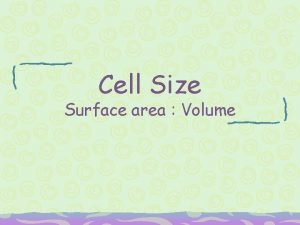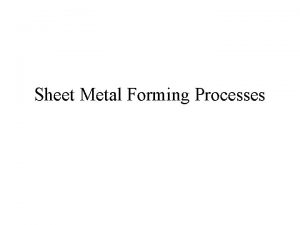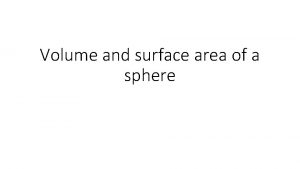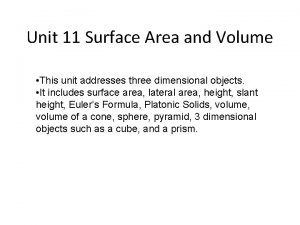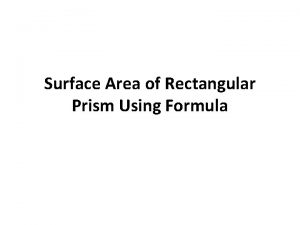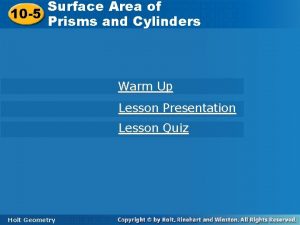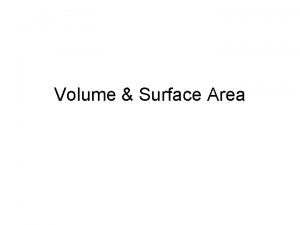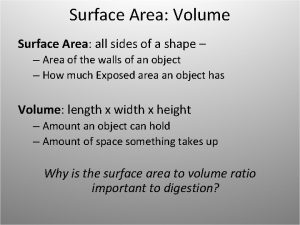Surface Area to Volume Ratio The surface area













- Slides: 13

Surface Area to Volume Ratio • The surface area to volume ratio refers to the ratio of the cell’s total surface area in relation to its volume. • Maximizing surface area to volume ratios is important so that the transport systems in cells can run efficiently

Surface- to- Volume Ratio Importance • A. Cells can only be so small. (There has to be enough room (volume) to hold things and to perform work inside a cell. ) • B. Cells can only be so large. (Larger means more traffic going in both directions across the cell membrane) • C. A cell must be large enough to contain DNA, Ribosomes, and some cytoplasm. They can only be so big because we have to be able to move enough “Food” into and “waste” out of a cell efficiently. If it is too large the cell becomes inefficient at moving these things so it divides to get back to a smaller state.

Surface Area to Volume Ratio • Reasons for keeping cell sizes small • Decreases distances that substances have to travel … increasing the rate of diffusion.

Human Systems • Cardiovascular system (alveoli in the lungs and capillaries that surround them aid in the diffusion of O 2 and CO 2 in and out of the blood)

Plant Systems • Structures in plants are also designed to maximize surface area to volume ratios for their specific functions. • Examples: • Leaf thickness and shape

Plant Systems • Root structures

Surface Area to Volume relationship

Surface Area to Volume Ratio • If we were to watch nutrients being absorbed at a constant rate in 3 different size cubes, the nutrients could reach the entire cytoplasm of smaller cells because, for their volume, they had a much larger surface area. 2 cm 3 4 cm 3 1 cm 3 Dead: nutrients can’t get to all parts of the cell. Surface Area = but still Alive! Nutrients make it to The. Better, smaller the cell, dead. all parts of the cell. the larger the SA / V ratio, and the (base) (height) easieradded it isup for to reach fordiffusion all sides all parts of the cell S. A. = (4 cm)(6 sides) S. A. = (2 cm)(6 sides) S. A. = (1 cm)(1 cm)(6 sides) = 96 cm 2 x 1 cube = 96 cm 2 = 24 cm 2 x 8 cubes = 192 cm 2 = 6 cm 2 x 64 cubes = 384 cm 2 Volume = (base) (width) (height) V = (4 cm)(4 cm) = 64 cm 3 x 1 cube = 64 cm 3 V = (2 cm)(2 cm) = 8 cm 3 x 8 cubes = 64 cm 3 V = (1 cm)(1 cm) = 1 cm 3 x 64 cubes = 64 cm 3

• Shape also affects surface area to volume ratio. 16 7. 11 • Skinnier, flatter cells large SA / V ratios. • Cells with projections, like microvilli, have large SA / V ratios.

• In order for an organism to be large, it must be multi cellular. • Which of the equal volumes below has the greatest SA / V Ratio and is therefore most likely to survive?



 Importance of surface area to volume ratio
Importance of surface area to volume ratio Ratio of volume to surface area
Ratio of volume to surface area Equator in mitosis
Equator in mitosis Sheet metal introduction
Sheet metal introduction What is a lateral face
What is a lateral face Wet curved surface area
Wet curved surface area What is the formula for the volume of a hemisphere
What is the formula for the volume of a hemisphere Lateral area vs total surface area
Lateral area vs total surface area Unit 11: volume and surface area
Unit 11: volume and surface area Surface area of a rectangular prism formula
Surface area of a rectangular prism formula Lesson 10-4 surface area of prisms and cylinders
Lesson 10-4 surface area of prisms and cylinders Prism volume and surface area
Prism volume and surface area Curved surface area of cone formula
Curved surface area of cone formula Volume and surface area of pyramid
Volume and surface area of pyramid

